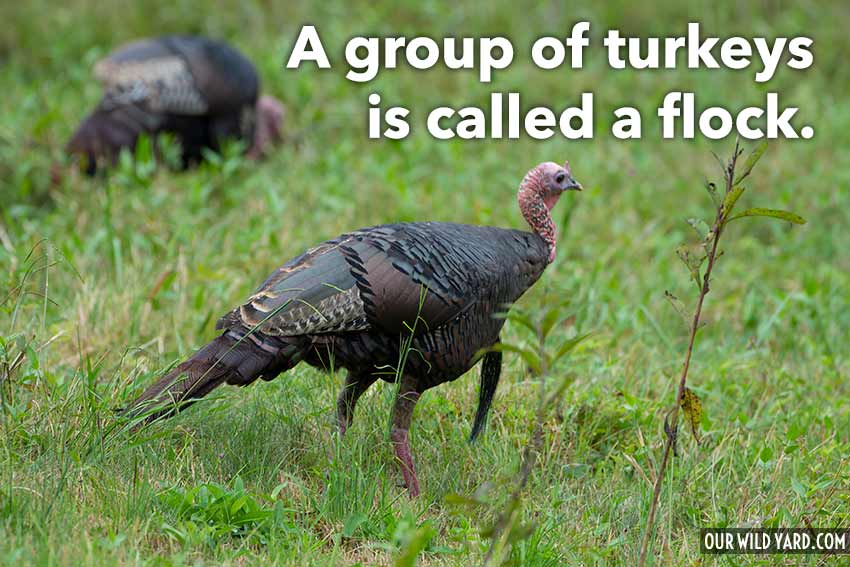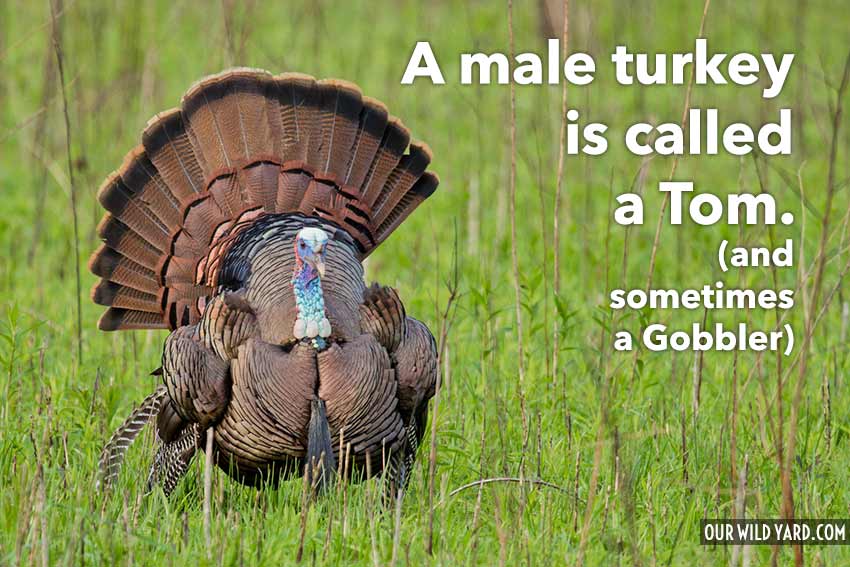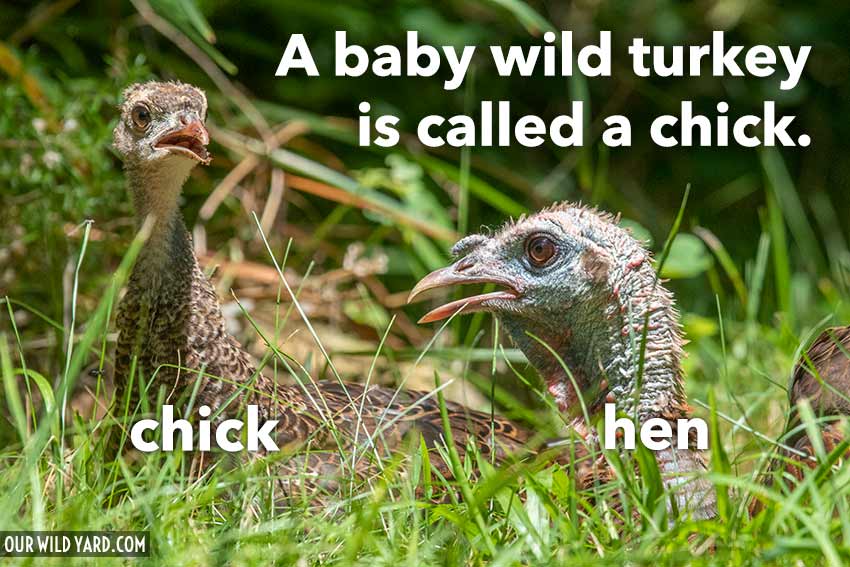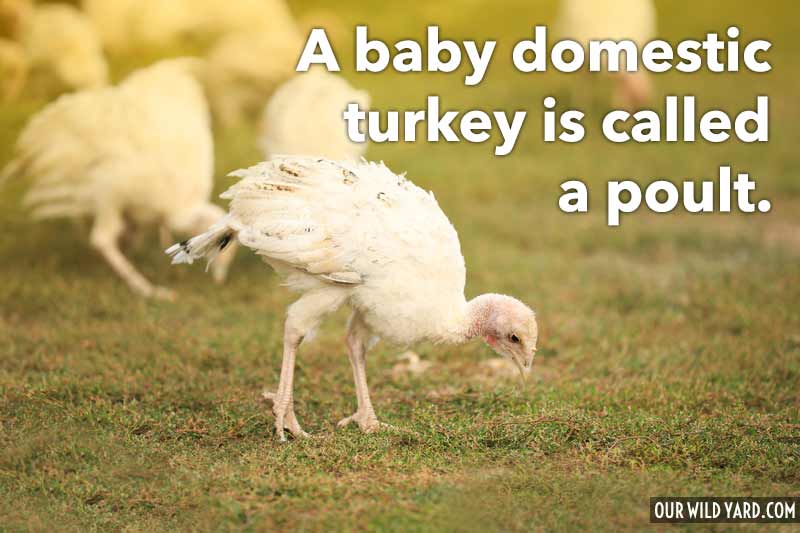Today I had an amazing encounter with a family of turkeys in our yard. Two baby turkeys and their mother spent more than an hour relaxing and walking around. I wrote all about the encounter here (turkey vs. bird garden statue) but as I was writing I kept wondering what are baby turkeys called? Well now I know! So let’s jump in and find out the proper name for a baby turkey.
Turkeys are a familiar bird species that is an integral part of many holiday traditions and cuisine. But while most people can easily recognize a male turkey, known as a tom many are unsure what to call the female of the species. So what do you call a female turkey?
There are a couple different terms used to refer to female turkeys, depending on the bird’s age:
-
Adult females are called hens This is the most common name used for female turkeys,
-
Juvenile females are called jennies This term refers specifically to young female turkeys less than one year old
The use of the terms “hen” and “jenny” to distinguish adult and juvenile female turkeys is very similar to chicken terminology. Adult female chickens are hens, while juvenile females are called pullets.
Let’s take a closer look at some key facts about female turkeys, including their physical traits, behavior, breeding, and role in raising young:
Identifying Female Turkeys
Female turkeys, or hens, can be distinguished from males by a few key physical characteristics:
-
Size – Hens are much smaller than male turkeys, called toms. They weigh 8-12 pounds compared to 15-25 pounds for males.
-
Plumage – Hens have duller, brown-tipped feathers and lack the male’s colorful, iridescent plumage. Their heads are covered with feathers.
-
Beard – Some hens may develop a beard, but it is typically much thinner and shorter than a male’s beard.
-
Head – Hens lack the male’s bright red wattles and long, fleshy snood hanging from the beak. Their heads are more modestly colored.
-
Legs – Hens have shorter legs and lack the male’s thick, sharp spurs used for fighting.
Hen Behavior
Hens exhibit some distinct behaviors compared to their male counterparts:
- More passive, nurturing demeanor focused on caring for young
- Communicate using soft clucks and yelps, not gobbles
- Rarely strut or puff up feathers like males trying to attract mates
- Less aggressive/territorial than males toward other turkeys
- Form close social units with other hens and their offspring
The Breeding Process
-
Hens start breeding at around 1 year old and may lay 4-17 eggs in a single clutch.
-
Eggs incubate for 25-31 days before hatching. Hens diligently incubate eggs and raise young without male assistance.
-
Males provide no parental care and mate with multiple hens each breeding season. They do not form pair bonds.
-
Young turkeys, or poults, follow their mother hen closely to learn feeding and survival skills.
Caring for Poults
Hen turkeys dedicate much time and energy to raising new poults each breeding season:
-
Hen selects nest site, scratches shallow depression, and lines it with leaves. May reuse favorite sites.
-
Hen incubates eggs for over a month, turning them frequently. Leaves nest just 1-2 times a day to feed.
-
Eggs hatch over 1-2 days. Hen stays with poults in nest for first day, then leads them away.
-
Hen shows poults how to find food like insects, seeds, and berries. Poults can feed themselves right away.
-
Hen protects poults from predators, fanning tail, hissing, and attacking if needed.
-
Poults follow hen closely, communicating with peeps and chirps. Hen answers with soft clucks and purrs.
-
Hen leads poults to roost in trees at night. May take 4 tries to get poults to roost the first night.
-
Hen continues guarding poults for 4-10 weeks until they reach independence. The poults then join juvenile flocks.
Hen Behavior With Poults
A mother hen turkey is extremely attentive to her poults’ needs:
-
Broods poults at night and shields them from rain and cold.
-
Has keen awareness of predators like foxes, coyotes, raccoons. Will defend poults ferociously.
-
Teaches poults the calls to regroup if separated and warn of danger.
-
Leads poults on daily travel routes between feeding areas, water sources, dust baths.
-
Shows poults which foods are safe to eat and how to scratch and peck for food.
-
Allows chicks to huddle under her wings for warmth when resting.
Hen Communication With Poults
Hens use a variety of vocalizations to communicate with poults:
-
Clucks and purrs – Made continuously to show poults her location and reassure them.
-
Yelps – Loud, piercing calls to gather straying poults back to her.
-
Whines – Draws poults to food source.
-
Cutts – An alarm to make poults freeze in response to danger.
Poults communicate with the hen using high-pitched peeps and chirps to which she readily responds.
Differences Between Hens and Jennies
While the terms hen and jenny both refer to female turkeys, there are some differences between adult and juvenile females:
-
Age – Hens are mature females over 1 year old. Jennies are young females less than 1 year old.
-
Size – Jennies are smaller than full grown hens. They are slowly growing toward adult size.
-
Plumage – Jennies may have softer, lighter feathers than hens since their adult plumage is still coming in.
-
Behavior – Jennies stick close to mother hens to learn hunting and survival skills. They are not yet breeding.
-
Broodiness – Hens participate in incubating eggs and rearing poults. Jennies are not mature enough to breed.
-
Social – Jennies stay with their mother’s flock. Hens sometimes leave to start their own brood.

So What is a Group of Turkeys Called?
A group of turkeys is called a flock. Some folks may tell you that a group of turkeys is called a rafter, but much like a “murder of crows” it’s not really used by researchers or in common language, only by folks who like to show off their knowledge of obscure trivia from very old books (like the Book of Saint Albans 1486).

While chick and flock seem like pretty common bird names, there are a few more unusual turkey names. An adult male turkey is called a Tom or a Gobbler. An adult female turkey is a hen. A juvenile male turkey may be called a Jake while a juvenile female turkey might be referred to as a Jenny (according to the Maryland DNR)

So let’s put some of our new lingo into use with an interesting turkey fact! Tom’s take no part in raising the chicks. The hen will raise them by herself and eventually may band into a flock with other hens and their broods! (find other cool turkey info from the Cornell Lab of Ornithology)
What is the Correct Name for a Baby Turkey?
The correct name of a baby turkey depends on which kind of turkey you’re talking about. There are only two wild species of turkey in the world, the Wild Turkey (Meleagris gallopavo) is the one Americans are likely to find walking through their yard and is found in every U.S. state except Alaska. The Ocellated Turkey (Meleagris ocellata) is only found in the Yucatán Peninsula of Mexico. Any wild baby turkey is called a chick. That shouldn’t be hard to remember, it’s just like a chicken!

However, there is a slightly different answer if you’re talking about domestic turkeys, the kind raised on a farm that you might eat for Thanksgiving. Domestic turkeys are actually descendants of the Wild Turkey which were probably first domesticated by the Mayans in Mexico up to 2,000 years ago! So what are baby turkeys called if they’re domestic? You can still call them a chick, but a more common name is a poult. It’s like the word poultry with the end cut off.

Poult can be used for the babies of any domesticated fowl that’s being raised for food, like chickens or pheasants, but is used most frequently for baby turkeys.
Best Wild Turkey Hen Calling and Yelping 2
FAQ
What do you call a female and male turkey?
Is a female turkey called a tom?
What does it mean to call a woman a turkey?
